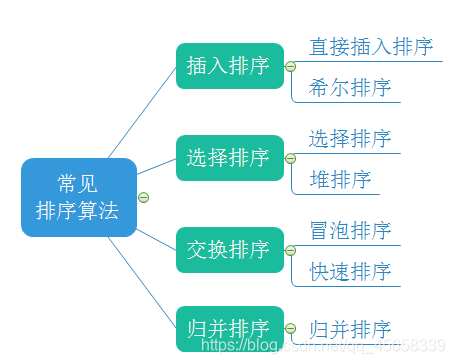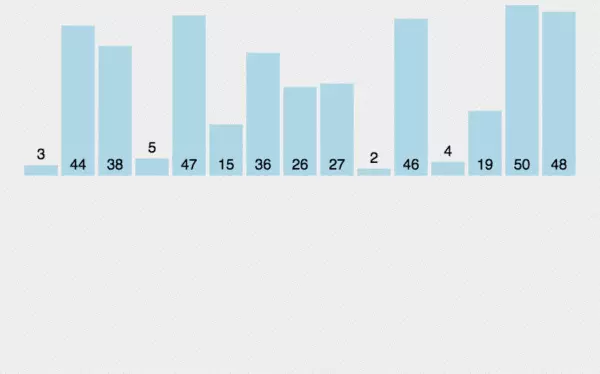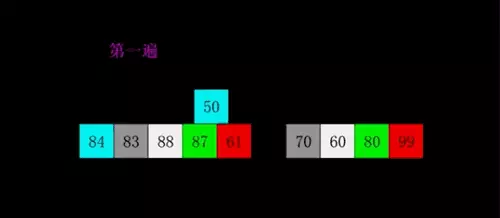
1、插入排序:(元素少时插排最快)
1、[ 有序区间(黄色区间),无序区间(蓝色区间) ]
每次操作:
- 1、抓无序区间(右侧蓝区)的第一张牌(红色牌)
- 2、依次和有序区间(左侧黄区)的牌比较(绿色为正在比较的牌)
- 3、选择适合的位置插入
动图展示:

代码实现:
public static void insertSort(long[] array) {
for (int i = 0; i < array.length - 1; i++) {
//1、抓无序区间第一张牌(红色牌)
long key = array[i + 1];
//2、将取出的牌依次和有序区间的牌比较
int j;
for (j = i; j >= 0; j--) {
//如果取出 红色的牌的值 < 绿色牌的值
if (key < array[j]) {
//将 绿牌 往后挪一个位置
array[j + 1] = array[j];
} else {
break;
}
}
//3、选择合适的位置插入
array[j + 1] = key;
}
}
性能分析:
| 时间复杂度 |
|
|
空间复杂度 |
| 最好 |
平均 |
最坏 |
|
| O(n) |
O(n^2) |
O(n^2) |
O(1) |
| 数据有序 |
|
数据逆序 |
|
具备稳定性(相等的两个数相对位置不会变),插入排序,初始数据越接近有序,时间效率越高
2、希尔排序:
希尔是发明者(ShellSort)
插排的优化版(分组插排排序)
排序步骤:(分为几组,就意味着中间间隔是多少)(组数一般为 数组长度 / 2)(下次的组数为上次组数的一半)
- 1、将数组按不同颜色依次分成了 5 组:然后进行组内比较大小,调换顺序
- 2、将第一次调整好的数组分成 2 组:然后进行组内比较大小,调换顺序
- 3、将第二次调整好的数组进行整体比较

动图展示:

代码实现:
public static void shellSort(long[] array) {
//gap为间隔,也就是分为了几组
int gap = array.length / 2;
while (true) {
insertSortGap(array,gap);
if (gap == 1) {
break;
}
//下次的组数为上次组数的一半
gap = gap / 2;
}
}
public static void insertSortGap(long[] array,int gap) {
for (int i = gap; i < array.length; i++) {
// key 为同一组中的第二个数
long key = array[i];
int j = 0;
//同一组中的第一个数
for (j = i - gap; j >= 0; j = j -gap) {
//第二个数 < 第一个数
if (key < array[j]) {
//第二个数的值 = 第一个数的值
array[j + gap] = array[j];
} else {
break;
}
}
//第一个数 = 之前保存的第二个数的值(此时的 j 是一个负数,加上 gap 刚好为第一个数)
array[j + gap] = key;
}
}
性能分析:
| 时间复杂度 |
|
|
空间复杂度 |
| 最好 |
平均 |
最坏 |
|
| O(n) |
O(n^1.3) |
O(n^2) |
O(1) |
| 数据有序 |
|
比较难构造 |
|
不稳定
3、选择排序:
[ 有序区间(黄色区间),无序区间(蓝色区间)]
每一次从无序区间选出最小(或最大)的一个元素,存放在无序区间的最前(或最后),直到全部待排序的数据元素排完
动图展示:

代码实现:
public static void selectSort(long[] array) {
for (int i = 0; i < array.length - 1; i++) {
//有序区间:[0,i)
//无序区间:[i,array.length]
int minIndex = i;//最小数下标
//先从无序区间中找到最小的数
for (int j = i + 1; j < array.length; j++) {
if (array[j] < array[minIndex]) {
minIndex = j;
}
}
//交换这个 最小数 和 无序区间的第一个数
long t = array[minIndex];
array[minIndex] = array[i];
array[i] = t;
}
}
性能分析:
| 时间复杂度 |
空间复杂度 |
| O(n^2) |
O(1) |
| 数据不敏感 |
数据不敏感 |
不稳定:(相等的两个数相对位置会变)
int[] a = { 9, 2, 5a, 7, 4, 3, 6, 5b };
// 交换中该情况无法识别,保证 5a 还在 5b 前边
4、堆排序:
随便给一组数据:[ 20,17,16,5,4,3 ]
(无序区间,我们用下划线的方式表示)(有序区间:用小蓝圈来表示)
排序流程:
- 1、建大堆:[ 20,17,4,16,5,3 ]
- 2、从大堆中找出最大值(堆顶元素),和无序区间的最后一个数字交换
- 3、此时数组中左边是无序区间,右边是有序区间,用来存放最大值
- 4、交换完数字后,需要对交换的堆顶元素进行向下调整为大顶堆(不包括有序区间)
- 5、循环遍历该过程
不能通过小堆来实现,因为有序区间放在开头的话,堆的逻辑结构就构不成二叉树了

代码实现:
public static void heapSort(long[] array) {
//1、建大堆
createHeap(array,array.length);
//2、进行选择的过程,一共需要 array.length - 1组
for (int i = 0; i < array.length - 1; i++) {
//无序区间:[ 0,array.length - 1]
//交换0号下标(大堆中0号下标为堆中最大值)和无序数组中最后一个元素
long t = array[0];
array[0] = array[array.length - 1 - i];
array[array.length - 1 - i] = t;
// 无序区间变为:[ 0,array - i - 1]
//向下调整
adjustDown(array,array.length-1-i,0);
}
}
//建大堆
private static void createHeap(long[] array, int size) {
for (int i = (size - 2) / 2; i >= 0; i--) {
adjustDown(array,size,i);
}
}
//向下调整
private static void adjustDown(long[] array, int size, int index) {
while (true) {
//1、判断该结点是不是叶子结点
int leftIndex = 2 * index + 1;
if (leftIndex >= size) {
//左孩子不存在,该节点是叶子结点
return;
}
//2、找出最大的孩子
int maxIndex = leftIndex;
int rightIndex = 2 * index + 2;
if (rightIndex < size && array[rightIndex] > array[maxIndex]) {
maxIndex = rightIndex;
}
//3、比较最大孩子和该节点的大小
if (array[index] >= array[maxIndex]) {
//当前结点的值大于两个孩子的值,则无须交换
return;
}
//4、交换
long t = array[index];
array[index] = array[maxIndex];
array[maxIndex] = t;
//5、将最大孩子视为 index,循环回去
index = maxIndex;
}
性能分析:
| 时间复杂度 |
空间复杂度 |
| O(n*log(n)) |
O(1) |
| 数据不敏感 |
数据不敏感 |
不稳定
5、冒泡排序:
[ 无序区间(蓝色区间),有序区间(黄色区间)]
绿色为两个正在比较的牌
在无序区间(蓝色区间),通过相邻两个数的比较,将最大的数冒泡到无序区间的最后,持续这个过程
动图展示:

代码实现:
public static void bubbleSort(long[] array) {
for (int i = 0; i < array.length - 1; i++) {
//无序区间:[0,array.length - 1]
//有序区间:[array.length - i,array.length]
//每次进行冒泡之前,假设数组已经有序
boolean isSorted = true;
//进行冒泡过程
for (int j = 0; j < array.length - i - 1; j++) {
if (array[j] > array[j + 1]) {
long t = array[j];
array[j] = array[j + 1];
array[j + 1] = t;
isSorted = false;
}
}
if (isSorted) {
break;
}
}
}
性能分析:
| 时间复杂度 |
|
|
空间复杂度 |
| 最好 |
平均 |
最坏 |
|
| O(n) |
O(n^2) |
O(n^2) |
O(1) |
| 数据有序 |
|
数据逆序 |
|
稳定(当两个数字相同时,不交换两个数字的位置)
6、快速排序:(重点)
步骤:
- 1、从数组中选择一个数(一般是最左边的那个数),作为基准
- 2、实现 partition 方法(小于 基准的放 左边,大于 基准的放 右边)
- 3、分别对左右两个区间按同样的方法处理
- 4、直到(小区间有序: size = 0 / 1)
例如:给定数组:[ 5,2,1,7,3,6,9 ]
(我们用红框来表示基准)
解法类似一颗二叉树

最终结果: [ 1,2,3,5,6,7,9 ]
动图展示:

代码实现:
public static void quickSort(long[] array) {
quickSortInternal(array,0,array.length - 1);
}
//给定位置之间采用快排
private static void quickSortInternal(long[] array, int lowIndex, int highIndex) {
//4、区间内的个数 = 0 / 1时,结束
int size = highIndex - lowIndex + 1;
if (size <= 1) {
return;
}
//1、选出一个数(选择最左边的)- array[lowIndex]
//2、执行 partition,小的放左,大的放右
//keyIndex 是经过 partition之后,选出来的数最终所在的下标(一次 partition之后,红框的位置)
int keyIndex = partition(array,lowIndex,highIndex);
//3、分别对左右区间进行相同处理 - 递归
quickSortInternal(array,lowIndex,keyIndex - 1);
quickSortInternal(array,keyIndex + 1,highIndex);
}
//以选出的 lowIndex 位置下的元素为基准,遍历数组,把比基准元素小的放到他左边,比他大的放右边
private static int partition(long[] array, int lowIndex, int highIndex) {
//选择合适的方法:
//方法1:
//return hover(array,lowIndex,highIndex);
//方法2:
//return digAHole(array,lowIndex,highIndex);
//方法3:
return doublePointer(array,lowIndex,highIndex);
}
实现 partition 方法:

private static int hover(long[] array, int lowIndex, int highIndex) {
int leftIndex = lowIndex;
int rightIndex = highIndex;
// 选择的数是最左边的一个
long key = array[lowIndex];
//选择了最左边,从右边先开始
//因为从右边写起来比较简单,从左边开始写需要处理特殊情况,较复杂
while (leftIndex < rightIndex) {
while (leftIndex < rightIndex && array[rightIndex] >= key) {
rightIndex--;
}
while (leftIndex < rightIndex && array[leftIndex] <= key) {
leftIndex++;
}
//rightIndex下标遇到比基数小的数,leftIndex下标遇到比基数大的数,则,交换两个数字
swap(array,leftIndex,rightIndex);
}
swap(array,lowIndex,leftIndex);
return leftIndex;
}
private static void swap(long[] array,int index1,int index2) {
long t = array[index1];
array[index1] = array[index2];
array[index2] = t;
}

private static int digAHole(int[] array, int lowIndex, int highIndex) {
//key 代表基数,将其挖出,则该位置为空
int key = array[lowIndex];
int leftIndex = lowIndex + 1;
int rightIndex = highIndex;
//只有两个元素的情况
if (leftIndex == rightIndex) {
if (array[leftIndex] >= key) {
return lowIndex;
} else {
int tmp = key;
key = array[leftIndex];
array[leftIndex] = key;
return leftIndex;
}
}
while (leftIndex < rightIndex) {
while (leftIndex < rightIndex && array[rightIndex] >= key) {
rightIndex--;
}
//把右边小于基数的那个数填到之前左边挖出的坑中
array[lowIndex] = array[rightIndex];
while (leftIndex < rightIndex && array[leftIndex] < key) {
leftIndex++;
}
//把左边大于基数的那个数填到上边空出的那个位置
array[rightIndex] = array[leftIndex];
lowIndex = leftIndex;
}
//将 key 放回剩余的坑中
array[rightIndex] = key;
return rightIndex;
}
设置两个指针,依次往后遍历,当遇到 > 基准值的时候,让 separateIndex下标不动,i 继续遍历,遍历到 < 基准值的时候,交换两下标的值,最后交换 separateIndex 的前一个值和基准的值

private static int doublePointer(long[] array, int lowIndex, int highIndex) {
int separateIndex = lowIndex + 1;
for (int i = lowIndex + 1; i <= highIndex; i++) {
if (array[i] < array[lowIndex]) {
swap(array,i,separateIndex);
separateIndex++;
}
}
swap(array,lowIndex,separateIndex - 1);
return separateIndex - 1;
}
private static void swap(long[] array,int index1,int index2) {
long t = array[index1];
array[index1] = array[index2];
array[index2] = t;
}
性能分析:
每一次 partition 时间复杂度是 O(n),一共多少层,看二叉树的高度(二叉树一般是 log(n),最坏是 n)
| 时间复杂度 |
|
|
空间复杂度 |
|
|
| 最好 |
平均 |
最坏 |
最好 |
平均 |
最坏 |
| O(n*log(n)) |
O(n*log(n)) |
O(n^2) |
O(log(n)) |
O(log(n)) |
O(n) |
|
|
数据有序 |
|
|
|
不稳定
快排优化:
- 1、partition 挖坑(小细节优化)
- 2、数量比较少的时候,不是最快(当区间的个数低于某个阈值时(16),使用插排)
- 3、优化选择特殊的数的方式
(1)随机数
(2)挑几个数,选大小为中间值的(三数取中)
- 4、把相等的值特殊处理
7、归并排序:(重点)
分治法 思想:
- 1、把数组平均分成两份。分别对左右两个区间,进行相同方式处理(归并排序),直到区间内个数(size = 0 / 1)
- 2、合并左右两个有序数组


代码实现:
public static void mergeSort(long[] array) {
mergeSortInternal(array,0,array.length);
}
//区间范围时左闭右开的
// array[lowIndex,highIndex ]
private static void mergeSortInternal(long[] array, int lowIndex, int highIndex) {
int size = highIndex - lowIndex;
if (size <= 1) {
return;
}
int midIndex = (highIndex + lowIndex) / 2;
// 左区间:[lowIndex,midIndex)
// 右区间:[midIndex,highIndex)
mergeSortInternal(array,lowIndex,midIndex);
mergeSortInternal(array,midIndex,highIndex);
// 左右两个区间有序,进行合并
mergeOrderedIntervals(array,lowIndex,midIndex,highIndex);
}
// 新建一个额外数组,将需要合并的两个数组中依次取出元素进行比较,在放入额外数组中
private static void mergeOrderedIntervals(long[] array, int lowIndex, int midIndex, int highIndex) {
int size = highIndex - lowIndex;//新数组长度
long[] extra = new long[size];
int leftIndex = lowIndex;//左边数组的下标
int rightIndex = midIndex;//右边数组的下标
int i = 0;//新数组下标
// 两个数组中都有元素
while (leftIndex < midIndex && rightIndex < highIndex) {
// <= 保证稳定性
if (array[leftIndex] <= array[rightIndex]) {
extra[i] = array[leftIndex];
leftIndex++;
} else {
extra[i] = array[rightIndex];
rightIndex++;
}
i++;
}
// 已经有数组空了,则将另外一个数组全部放入新数组中
if (leftIndex < midIndex) {
//右边数组为空
while (leftIndex < midIndex) {
extra[i++] = array[leftIndex++];
}
} else {
//左边数组为空
while (rightIndex < highIndex) {
extra[i++] = array[rightIndex++];
}
}
//在将原数组中的值换为新数组的值
for (int j = 0; j < size; j++) {
array[lowIndex + j] = extra[j];
}
}
性能分析:
| 时间复杂度 |
空间复杂度 |
| O(n*log(n)) |
O(n) |
| 数据不敏感 |
数据不敏感 |
稳定
扩展:
排序算法都是在内存中进行的,当出现 海量数据 时,内存存不下,必须借助硬盘,采用归并排序(多路归并)
步骤:
- 1、先将数据平均分为 n 份(每份的大小较小)
- 2、分别对每份数据进行排序
- 3、至此,得到 n 个分别有序的数据文件
- 4、借助内存,进行 n 个有序数据文件的合并
(1)将每份文件中最小的数放入内存中
(2)将最小的数选出来,尾插到最后的有序文件中
n 多个数据以文件的形式放到磁盘上,把每个数据的第一个数选出来作为代表放到内存中,比较,谁小就放到最终的结果文件中,尾插进去

排序总结:

| 排序方法 |
最好 |
平均 |
最坏 |
空间复杂度 |
稳定性 |
| 插入排序 |
O(n) |
O(n^2) |
O(n^2) |
O(1) |
稳定 |
| 希尔排序 |
O(n) |
O(n^1.3) |
O(n^2) |
O(1) |
不稳定 |
| 选择排序 |
O(n^2) |
O(n^2) |
O(n^2) |
O(1) |
不稳定 |
| 堆排序 |
O(n*log(n)) |
O(n*log(n)) |
O(n*log(n)) |
O(1) |
不稳定 |
| 冒泡排序 |
O(n) |
O(n^2) |
O(n^2) |
O(1) |
稳定 |
| 快速排序 |
O(n*log(n)) |
O(n*log(n)) |
O(n^2) |
O(log(n)) ~ O(n) |
不稳定 |
| 归并排序 |
O(n*log(n)) |
O(n*log(n)) |
O(n*log(n)) |
O(n) |
稳定 |